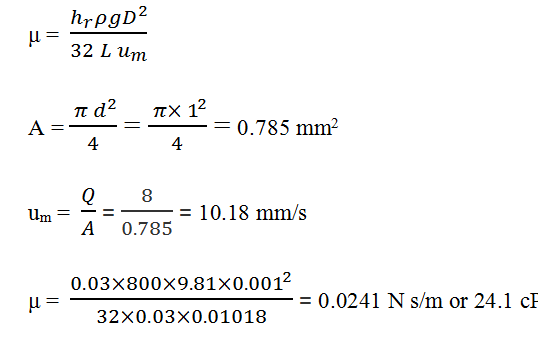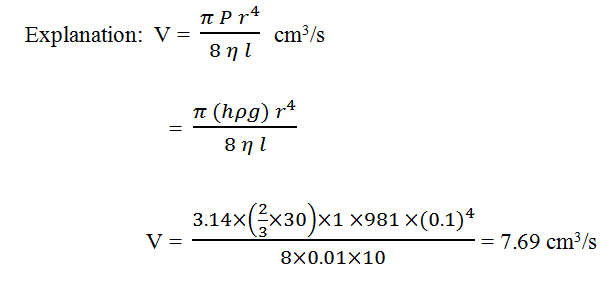This set of Bioprocess Engineering Multiple Choice Questions & Answers (MCQs) focuses on “Viscosity Measurement”.
1. What value of angle Φ is between the plate and cone in Cone-and-Plate viscometer?
a) More than 3°
b) Less than 3°
c) More than 2°
d) More than 5°
View Answer
Explanation: The angle Φ between the plate and cone is very small, usually less than 3°, and the fluid to be measured is located in this small gap. Large cone angles are not used for routine work for a variety of reasons, the most important being that analysis of the results for non-Newtonian fluids would be complex or impossible.
2. A small spherical ball of diameter 5mm is thrown into a well of water and it moves with a terminal velocity 10cm/s. Calculate the density of the spherical ball. Given that viscosity of water is 0.01poise.
a) 1.0083 gm/cm3
b) 1.0000 gm/cm3
c) 1.0023 gm/cm3
d) 1.0073 gm/cm3
View Answer
Explanation: According to Stoke’s theorem,
\(v_t = \frac{2}{9} \frac{r^2}{\eta} (\sigma – \rho) g\)
Here,
\((\sigma – 1) = \frac{10×9×0.01}{2×(0.25)^2×981}\) = 0.0073
= 1.0073 gm/cm3
3. Which one of the following is not applicable to rotating spindle viscometer?
a) Penicillium chrysogenum
b) Saccharomyces cerevisiae
c) Aspergillus niger
d) Streptomyces aureofaciens
View Answer
Explanation: Penicillium chrysogenum has a Shear rate (s-1) of 1-15 and is a Casson plastic and applicable under Turbine impeller.
4. Which one of the following is not applicable to Coaxial cylinder?
a) Endomyces sp.
b) Streptomyces aureofaciens
c) Penicillium chrysogenum
d) Xanthomonas campestris
View Answer
Explanation: Xanthomonas campestris has a Shear rate (s-1) of 0.0035-100 and is a pseudoplastic, K increases continually; n levels off when xanthan concentration reaches 0.5%; cell mass (max 0.6%) has relatively little effect on viscosity.
5. Oil flows in a pipe 100 mm bore diameter with a Reynolds’ Number of 500. The density is 800 kg/m3. Calculate the velocity of a streamline at a radius of 40 mm. The viscosity µ = 0.08 Ns/m2.
a) 0.60 m/s
b) 0.26 m/s
c) 0.36 m/s
d) 0.66 m/s
View Answer
6. What influences viscosity?
a) Temperature
b) Time
c) Velocity
d) Speed
View Answer
Explanation: Along with the shear rate, temperature really is the dominating influence. The higher the temperature is, the lower a substance’s viscosity is. Consequently, decreasing temperature causes an increase in viscosity. For some fluids a decrease of 1°C already causes a 10 % increase in viscosity.
7. A capillary tube is 30 mm long and 1 mm bore. The head required to produce a flow rate of 8 mm3/s is 30 mm. The fluid density is 800 kg/m3. Calculate the dynamic viscosity of the oil.
a) 20.1 cP
b) 24.1 cP
c) 20.0 cP
d) 24.0 cP
View Answer
8. Taking question 7 into consideration, and calculate the kinematic viscosity of the oil.
a) 30.11 cSt
b) 30.19 cSt
c) 35.11 cSt
d) 35.19 cSt
View Answer
Explanation: v = μ/ρ = 0.0241/800 = 30.11×10-6 m2/s or 30.11 cSt.
9. Which of the following factors do not determine the Blood viscosity?
a) Color
b) Erythrocyte deformability
c) Plasma viscosity
d) Temperature
View Answer
Explanation: Five primary factors determine blood viscosity. These include hematocrit, erythrocyte deformability, plasma viscosity, erythrocyte aggregation, and temperature. Hematocrit is the most obvious determinant of WBV. A higher percentage of red blood cells (RBCs) results in thicker blood.
10. At the bottom of a uniform cylindrical vessel of 30 cm height a horrizontal capillary tube of 2mm inner diameter and 10 cm length is connected to discharge the liquid. Calculate the rate of discharge of the liquid if the vessel contains water of viscosity 0.01 poise to its 2/3 capacity. Take the density of water as 1 gm/cc.
a) 7.59 cm3/s
b) 6.59 cm3/s
c) 7.69 cm3/s
d) 6.69 cm3/s
View Answer
11. Taking question 10 into consideration, and Calculate the rate of discharge of the liquid if the vessel contains oil of viscosity 0.84 poise to its 2/3 capacity. Take the density of oil as 0.9 gm/cc.
a) 0.08 cm3/s
b) 0.06 cm3/s
c) 1.08 cm3/s
d) 1.06 cm3/s
View Answer
Sanfoundry Global Education & Learning Series – Bioprocess Engineering.
To practice all areas of Bioprocess Engineering, here is complete set of 1000+ Multiple Choice Questions and Answers.
If you find a mistake in question / option / answer, kindly take a screenshot and email to [email protected]
- Check Bioprocess Engineering Books
- Check Biotechnology Books
- Apply for Biotechnology Internship
- Practice Biotechnology MCQs




